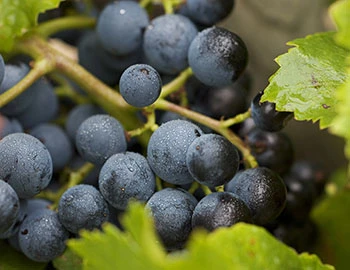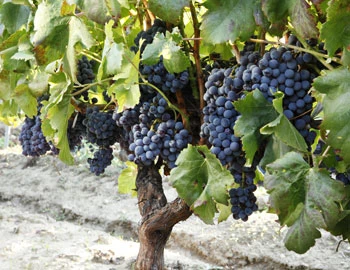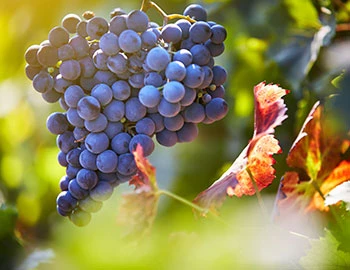
Séguret rouge Cuvée Garnacho 2022
AOP Côtes-du-Rhône Village, Domaine de Cabasse, 750 ml

| Grape variety: | Grenache, Syrah, Carignan, Counoise |
| Producer: | Domaine de Cabasse |
| Origin: | France / Rhône / Côtes du Rhône/Villages |
| Other vintages: |
Description
Aromas of ripe fruit with a velvety note and a hint of spice caress the nose. On the palate, it is powerful, full-bodied, with well-integrated tannins and a long finish. A full-bodied and at the same time fruity wine that excellently brings out the character of the Grenache grape.
Attributes
| Origin: | France / Rhône / Côtes du Rhône/Villages |
| Grape variety: | Grenache, Syrah, Carignan, Counoise |
| Ripening potential: | 7 to 8 years |
| Drinking temperature: | 16 to 18 °C |
| Food Pairing: | Spiced grillades, Cheese board |
| Vinification: | fully destemmed, fermentation in steel tank |
| Harvest: | hand-picking |
| Maturation: | in large wooden barrel/foudre |
| Maturation duration: | 9 months |
| Volume: | 14.0 % |
| Note: | Contains sulphites |
Domaine de Cabasse
This winery is situated amidst vines between the towns of Séguret and Sablet, a half-hour drive from Orange, or Châteauneuf-du-Pape. The origins of the Domaine de Cabasse date back to when the Papal seat was in Avignon. Over time, the original Italian name Casa Bassa (the house below the village) became Cabasse.
In 1990, the Swiss Häni family acquired the domaine and worked continuously to establish the reputation it enjoys today. In 2012, the Baudry family bought the entire hotel and winery and continues to manage it with the same attention to high quality.
The estate now covers 34 hectares in the municipalities of Séguret, Sablet and Gigondas and cultivates a wide range of grape varieties: Syrah, Grenache, Mourvèdre, Counoise, Carignan, Clairette and other white grape varieties. These communes are some of only 16 villages which may use their name along with the Côtes-du-Rhône Villages appellation. The plots are not overly large and are surrounded by hedges and trees that protect the vines from the cold mistral which can blow violently from the north. Otherwise, the climate in the already very broad Rhone valley is Mediterranean. The soils are mainly composed of weathered limestone with varying clay, sand and stone content.

Carignan
Fervid oddball
The red Carignan is a heat-loving Mediterranean grape. It has a bit of everything over other varieties: more colour, more tannins, more acid. It is not easy to press a harmonious wine from it alone. Hence it is most often encountered as a blend partner, as in the Côtes du Rhône wines. In Spain it is called Mazuelo and is part of the traditional Rioja recipe. It provides the wines’ acidic backbone. The most exciting varietal specimens come from the slate slopes of the Catalan Priorat (named here Cariñena), from old bush vines in Chile or from Sardinia, where it is known as Carignano. When pressed properly, this oddball generates a lush bouquet of plums and dark fruits. Its origins lie in the northwest Spanish Aragon, near the town of Cariñena. The surrounding wine area is also named after it. In order to prevent confusion with the vine, it is called Samsó there.

Grenache
Grenache seldom comes alone
Spaniards and Sardinians make the Grenache contentious: both claim it originated from their country. In fact, it had already appeared in both places by the 16th century. But a large number of mutations in Spain indicates that it has deeper roots on the Iberian Peninsula. The Grenache is meaty and spicy, with a wonderful, fruity sweetness and rich aromas of blackberry, cassis, plums and pepper. Under the name Garnacha, it contributes fullness to the Rioja. In Sardinia it is called Cannonau, where it yields strong, expressive wines. But its stronghold is in France. Grenache is the star in Châteauneuf-du-Pape and streams into many other assemblages from the south. Its preferred partners are Syrah and Mourvèdre. This blend is also very popular abroad. In Australia, these wines are simply called "GSM".

Counoise
Crisp, rare and elegant
This sparsely-stocked red grape spawns astonishingly crisp wines. It is cultivated in small quantities in the southern Rhône Valley and the Languedoc. However, it originated in Spain. Legend has it that Pope Urban V (1310-1370), the penultimate Avignon Pope, received a vine as a gift from a Spaniard named Counesa.
This variety matures late, with weak productivity; its high quality makes up for it, though. In total, nearly 1,000 hectares are planted with Counoise in France. Wines pressed from the Counoise grape are mostly light in color, elegant, multi-layered, and fruity.

Syrah
A hint of pepper
The legend stubbornly persists that the Syrah variety came from the Persian city of Shiraz. Yet, researchers have shown that it is a natural crossing of two old French varieties: the red Dureza from the Rhône Valley and the white Mondeuse blanche from Savoy. Wines from Syrah are gentle and concentrated. They smell of dark berries, violets and liquorice, and amaze with a piquant touch of white pepper. As varietal wines, they are found on the northern Rhone, as in the Hermitage or Côte Rôtie appellations, as well as in Swiss Valais. In the southern Rhône Valley, Syrah is often wedded with Grenache and Mourvèdre. In 1832, a Frenchman brought the variety to Australia, where it became the emblem of the national wine industry. There, the weightiest versions develop with typical notes of tar and chocolate.

Rhône
Rhône: northern power, southern charm
The Rhône’s source is in Valais, and it flows into the Mediterranean 800 kilometres to the south. In the last 200 kilometres of its course, it is lined with vines which yield a range of red crus that are among the most prestigious wines in the world – for example, on the spectacular cliffs of the Hermitage Mountains, or in the gravelly terraces of Châteauneuf-du-Pape. The river valley, however, is also a rich source of characterful white wines and affordable, high-quality, everyday red wines.

France
France – Philosophy in a bottle
According to French philosophy, wine should be an expression of the soil and climate. They use the word “terroir” to describe this. Terroir makes every wine different, and many especially good. French wine is regarded worldwide as an expression of cultural perfection. The French believe that humans are responsible for the quality of the berries, the vine variety for their character, and nature for the quantity. This philosophy can be expressed succinctly as: “the truth is the vineyard, not the man.”


